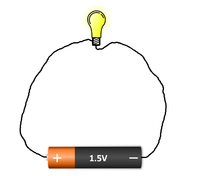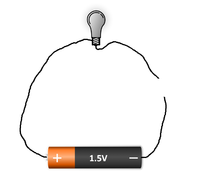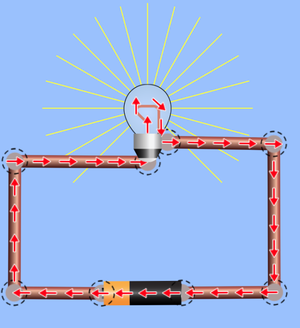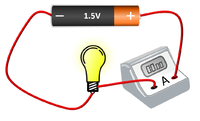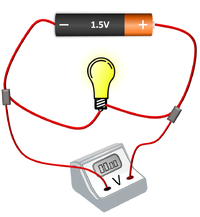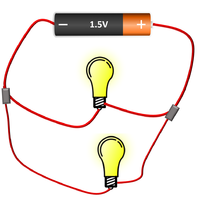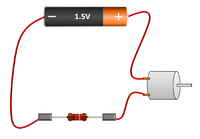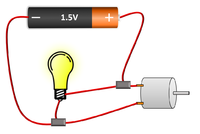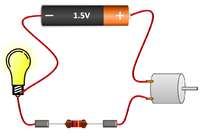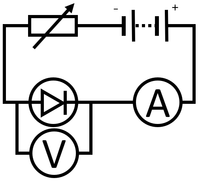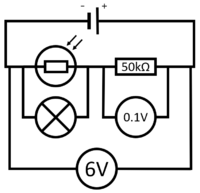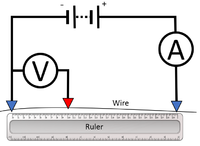Circuit
Contents
Key Stage 2
Meaning
A circuit is a loop of wire that electricity flows around.
About Circuits
- A circuit needs to be complete otherwise electricity will not flow through it. Any break in the circuit will stop the electricity from flowing.
- A circuit starts and ends at the source of power. This is usually a battery or cell but it can be a generator or Solar Cell.
| A circuit must be a complete loop without any breaks or it will not work. | The break in this circuit stops it from working. |
To practice building a circuit you can use a circuit simulator by clicking on the picture below.
Key Stage 3
Meaning
A circuit is a loop of wire that electricity flows around.
About Circuits
- Circuits can have components in series or parallel.
- Components in parallel in a circuit have the same Potential Difference across them but share the Current.
- Components in series in a circuit have the same Current through them but share the Potential Difference.
Examples
| The bulb and Ammeter are in series so they have the same Current going through them. | The cell, bulb and Voltmeter are in parallel so they have the same Potential Difference across them. | The two bulbs are in parallel so they have the same Potential Difference across them but may have a different Current passing through them. |
| The motor and resistor are in series so they have the same Current passing through them but share the 1.5V Potential Difference between them. | The bulb and motor are in parallel so they have the same Potential Difference across them but may have a different Current passing through them. | The motor, resistor and bulb are in series so they all have the same Current passing through them but share the 1.5V Potential Difference between them. |
Energy Transfers
Cell
- Energy is transferred electrically out of the chemical potential energy store.
Light Bulb
- Energy is transferred electrically into the the thermal energy store of the bulb.
- Energy is also transferred away from the bulb by light radiation.
Motor
- Energy is transferred electrically into the the kinetic energy store of the motor as it speeds up.
- Energy is transferred electrically into the the thermal energy store of the motor due to friction.
Speaker or Buzzer
- Energy is transferred electrically into the the kinetic energy store of the Speaker.
- Energy is also transferred away from the Speaker by sound radiation.
Key Stage 4
Meaning
A circuit is a loop of wire that electricity flows around.
About Circuits
- Circuits can have components in series or parallel.
- Components in parallel in a circuit have the same Potential Difference across them but share the current.
- Components in series in a circuit have the same Current through them but share the potential difference.
Examples
| This circuit can be used to plot the IV Graph for a diode. | This circuit can be used to activate a lamp when it is dark. | This circuit can be used to find the resistance of a wire. |
Energy Transfers
Cell
- Energy is transferred electrically out of the chemical potential energy store.
Light Bulb
- Energy is transferred electrically into the the thermal energy store of the bulb.
- Energy is also transferred away from the bulb by light radiation.
Motor
- Energy is transferred electrically into the the kinetic energy store of the motor as it speeds up.
- Energy is transferred electrically into the the thermal energy store of the motor due to friction.
Electrical Heater
- Energy is transferred electrically into the the thermal energy store of the heater.
Speaker or Buzzer
- Energy is transferred electrically into the the kinetic energy store of the Speaker.
- Energy is also transferred away from the Speaker by sound radiation.
References
AQA
- Circuits, pages 180, 185, 186, GCSE Combined Science; The Revision Guide, CGP, AQA
- Circuits, pages 24-33, GCSE Physics; The Revision Guide, CGP, AQA
- Circuits, series, page 185, GCSE Combined Science; The Revision Guide, CGP, AQA
- Circuits; circuit diagrams, pages 60, 61, 235, GCSE Combined Science Trilogy; Physics, CGP, AQA
- Circuits; circuit diagrams, pages 62, 63, 331, GCSE Physics; The Complete 9-1 Course for AQA, CGP, AQA
- Circuits; investigating I-V characteristics, page 183, GCSE Combined Science; The Revision Guide, CGP, AQA
- Circuits; investigating resistance, pages 182, 187, GCSE Combined Science; The Revision Guide, CGP, AQA
- Circuits; parallel circuits, pages 72-76, 78, 79, GCSE Combined Science Trilogy; Physics, CGP, AQA
- Circuits; parallel circuits, pages 74-78, 80, 81, GCSE Physics; The Complete 9-1 Course for AQA, CGP, AQA
- Circuits; parallel, page 186, GCSE Combined Science; The Revision Guide, CGP, AQA
- Circuits; parallel, page 302, GCSE Combined Science Trilogy 1, Hodder, AQA
- Circuits; sensing, page 184, GCSE Combined Science; The Revision Guide, CGP, AQA
- Circuits; sensor circuits, page 81, GCSE Combined Science Trilogy; Physics, CGP, AQA
- Circuits; sensor circuits, page 83, GCSE Physics; The Complete 9-1 Course for AQA, CGP, AQA
- Circuits; series circuits, pages 68-71, 77, 78, GCSE Combined Science Trilogy; Physics, CGP, AQA
- Circuits; series circuits, pages 70-73, 79, 80, GCSE Physics; The Complete 9-1 Course for AQA, CGP, AQA
- Circuits; series, pages 295, 301-2, GCSE Combined Science Trilogy 1, Hodder, AQA
- Circuits; standard test circuit, page 67, GCSE Physics; The Complete 9-1 Course for AQA, CGP, AQA
Edexcel
- Circuits; diagrams, pages 219, 220, 338, GCSE Physics, CGP, Edexcel
- Circuits; investigating, pages 239-241, GCSE Physics, CGP, Edexcel
- Circuits; parallel, pages 235-238, GCSE Physics, CGP, Edexcel
- Circuits; series, pages 231-234, GCSE Physics, CGP, Edexcel
- Circuits; symbols, page 219, GCSE Physics, CGP, Edexcel
OCR
- Circuits, pages 100-115, 263, Gateway GCSE Physics, Oxford, OCR
- Circuits, pages 176, 178-182, Gateway GCSE Combined Science; The Revision Guide, CGP, OCR
- Circuits, pages 44, 45, 47-50, Gateway GCSE Physics; The Revision Guide, CGP, OCR
- Circuits; Calculations, pages 110-111, Gateway GCSE Physics, Oxford, OCR
- Circuits; Circuit boards, pages 104, Gateway GCSE Physics, Oxford, OCR
- Circuits; Circuit diagrams, pages 260-261, Gateway GCSE Physics, Oxford, OCR
- Circuits; Electrical power, pages 114-115, Gateway GCSE Physics, Oxford, OCR
- Circuits; energy transferred in, pages 177, 182, Gateway GCSE Combined Science; The Revision Guide, CGP, OCR
- Circuits; energy transferred, pages 44, 50, Gateway GCSE Physics; The Revision Guide, CGP, OCR
- Circuits; Light-dependent resistors, pages 109, 113, Gateway GCSE Physics, Oxford, OCR
- Circuits; Model of, pages 96, Gateway GCSE Physics, Oxford, OCR
- Circuits; Net resistance, pages 110-111, Gateway GCSE Physics, Oxford, OCR
- Circuits; parallel circuits, page 181, Gateway GCSE Combined Science; The Revision Guide, CGP, OCR
- Circuits; Parallel circuits, pages 103, 111, 260-263, Gateway GCSE Physics, Oxford, OCR
- Circuits; parallel circuits, pages 48, 49, Gateway GCSE Physics; The Revision Guide, CGP, OCR
- Circuits; Potential difference, pages 100-101, 113, 260-263, Gateway GCSE Physics, Oxford, OCR
- Circuits; Resistance, pages 104-105, 110-111, Gateway GCSE Physics, Oxford, OCR
- Circuits; sensing circuits, page 47, Gateway GCSE Physics; The Revision Guide, CGP, OCR
- Circuits; Sensing circuits, pages 112-113, Gateway GCSE Physics, Oxford, OCR
- Circuits; Series circuits, pages 102-103, 110, 260-263, Gateway GCSE Physics, Oxford, OCR
- Circuits; series circuits, pages 180, 181, Gateway GCSE Combined Science; The Revision Guide, CGP, OCR
- Circuits; series circuits, pages 48, 49, Gateway GCSE Physics; The Revision Guide, CGP, OCR
- Circuits; symbols, page 176 Gateway GCSE Combined Science; The Revision Guide, CGP, OCR
- Circuits; symbols, page 45, Gateway GCSE Physics; The Revision Guide, CGP, OCR
- Circuits; Temperature measurements, pages 112, Gateway GCSE Physics, Oxford, OCR
- Circuits; Thermistors, pages 108-109, 112, Gateway GCSE Physics, Oxford, OCR
